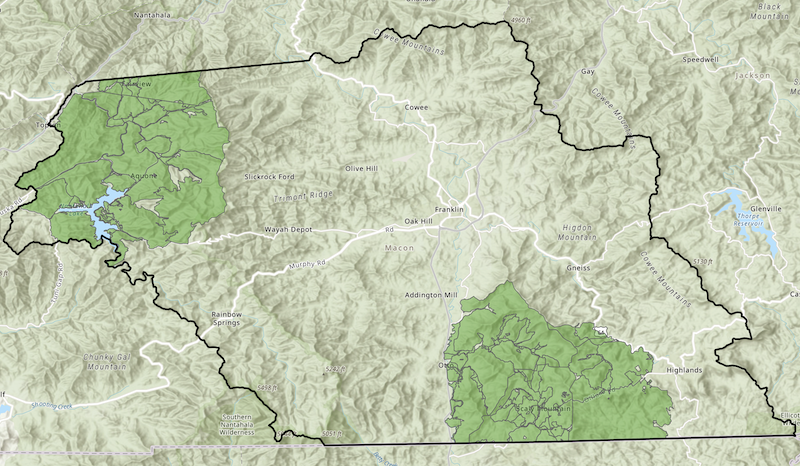Progress Update - January 2, 2022
Jeff Lee, Little T Broadband
Happy New Year to all! We hope everyone has had a safe and relaxing holiday season.
With the holidays behind us, we want to provide an update on our progress through the end of 2021.
South Macon Backbone
As many of you have been following, construction of the new fiber backbone network in South Macon continued through the end of the year. Along 441 the new aerial fiber from Addington Bridge Rd to Coweeta Church Rd is complete, and the majority of the underground fiber from Coweeta Church Rd to Brown Rd is installed. There is still a section to be installed up Firehouse Rd, splicing, and other work left to complete this leg.
Balsam West plans to have the construction complete along 441 in the coming weeks. Haywood EMC has also been working on fiber construction from Scaly Mountain to Highlands, though we do not have any status on that portion at this time. It is our hope barring weather and other unforeseen delays that the connection from Franklin to Scaly will be live by the end of the month.
Community Center Hotspots
We have made great progress on installation of the necessary equipment for hotspots. Wired Inc. of Franklin has completed most hotspot installation work in both the Otto and Scaly Mountain Community Centers and the Sky Valley-Scaly Mountain Volunteer Fire and Rescue facility. This equipment and the work to install was paid for through a grant from the North Carolina Student Connect program administered by the Southwestern Regional Commission. The remaining work required to complete connection of the hot spots will be funded by Little T Broadband.
Once fiber service reaches these facilities we will be able to activate public WiFi, and it is our hope that this will occur by the end of this month. Stay tuned, as we will make another announcement when these become active.
NTIA Grant and Fiber Expansion
We have received a number of questions from community members asking when to expect new internet service at their home. Though we all wish it to be tomorrow, unfortunately the answer is a bit uncertain and likely not soon for most of us.
The expansion of fiber service from the backbone into Otto, Scaly, and other areas outside the Highlands city limits is primarily dependent on federal and state grant funding, and the timing/availability of this funding has yet to be determined. These areas were included as part of a federal grant application submitted late last summer, and the outcome of that grant application will dictate the pace of expansion there. Though the application was filed in August, all applicants nationwide for the 2021 NTIA Broadband Infrastructure Grant program are still waiting for announcement of awards, which were delayed until sometime in early 2022. If the NTIA grant is not received, we will be applying to new grant programs that are being made possible through ARPA and the recently passed federal Infrastructure Bill to be released later this year, and unfortunately expansion work would be delayed accordingly.
Once a grant is received, we would expect active construction of expanded fiber service to begin within a few months of the grant announcement. This will depend on the exact timing of the grant funds, fiber contractor availability, materials availability, weather, and a variety of other factors. Fiber construction does take time, and assuming sufficient grant funding it is our expectation that to build out fiber in the Otto, Scaly, and surrounding Highlands area will take 1-2 years once it begins. Though the exact schedule for roll out of service will be determined by Balsam West and their contractors, it is reasonable to assume service will become available first to those locations immediately adjacent to the backbone network, and then construction and service will slowly radiate out from there. Those who live a number of miles from the backbone in areas more difficult to reach should expect a longer wait. Unfortunately, my home along with many others falls into that category.
There will likely be some service expansion immediately along the backbone once it becomes active independent of grant funding. However, this work will depend on private funding/investment from Balsam West and their stakeholders, and such expansion would be based on their internal business analyses for those areas.
How Can I Help?
As you likely know from our website and other info, Little T is an organization consisting of a very small group of unpaid volunteers. Though we have a few individuals who periodically help out on a consulting basis, our number of active members participating day to day is very limited.
Help is always welcome and we appreciate any and all offers. How you might be able to help would depend on your background, motivation, and availability. Feel free to contact us through the website if you would like to offer your time and/or expertise. Please make sure that you provide a valid email address and a phone number so that we may reach out to you. We have received some contact forms that may contain typos in the email address and no phone number, so if you have not heard back from us in a few days please try again making sure all of your contact info is correct.

